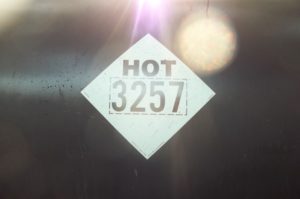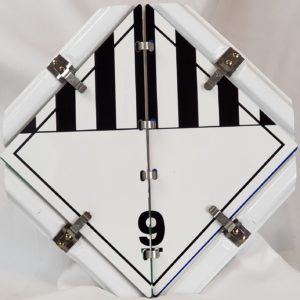A question I received back in April of 2018. From a guy understandably upset about the confusion over the regulations of his industry:
I have been in the asphalt industry for over 30 years…running asphalt spreaders and bulk delivery the majority of the time…in the past we have been required to list HOT on opposing sides of the bulk tank along with 3257 black letters on white back ground diamond shaped placards…i also have maintained a Hazmat endorsement for the last 30 years and I am quite familiar with all DOT requirements and regulations….
Some where along the line I have found out several construction companies in the <<City>> area are letting drivers who do not have Hazmat endorsements to haul elevated temperature materials..i.e. Hot asphalt with out placards or the required endorsement….
I read the HMR regulations one way…you must display Hot on at least 2 sides of the bulk tank…either with the designated 4 digit number 3257 on the upper point of the placard in 2 inch talk letters in italic design with a total of 4 placards front rear and each side of vehicle…
I am getting into a serious debate about this with a shop manager at my current employer…he swears you do not need placards or a hazmat….only what he refers to as Place cards…??? and the words hot…
???
I have read your argument with the above concerned person (he’s referring to this article: Q&A: The Display of “HOT” or the Identification Number Marking on Packages of Elevated Temperature Materials) and I agree with your conclusion that HOT asphalt above 212 degrees is considered a Hazardous material…and must be placard on 4 sides plus the identifying word of HOT on at least 2 sides of the bulk tank…
I understand both sides of the confusion and understand how someone could be mislead in attempting to decipher the language….
One must return to definitions to explain the terminology…i.e. MAY is meant to mean required…WILL or SHALL are meant as REQUIRED…
I agree asphalt below 212 degrees is not Hazardous material under the HMR regulations.but at 212 or above it becomes a Hazardous material.
For many different reasons….
All shippers in the valley who ship or transport elevated temperature materials or HOT asphalt still give each driver a BOL listing the hazards and other required information….
I guess you could say we have a bunch of DOT officers who do not know the law as well as several transportation companies who do not understand the legal accountability nor the drivers are aware the sever punishment that can be given to them for hauling Hazardous materials….i understand to be a minimum of 24 points on their CSA records and possible felony charges….
If you could elaborate on this it would be great…i am not sure even God himself with a personal appearance could convince the person I am debating with that you must have certain things in order and out line the exceptions that only HOT liquid asphalt is non Hazardous only below 212 degrees.
My reply that same day (God doesn’t do personal appearance for HazMat):
I will try to answer your questions. Please see below.
- You are correct that a substance meeting the definition of an elevated temperature material is a hazardous material subject to USDOT/PHMSA regulations.
- Requirements for an elevated temperature material include:
- Use of a shipping paper (a bill of lading is one possible example) including the additional description of “HOT”, “elevated temperature” or “molten”.
- The 4-digit identification number (3257 is the identification number for an elevated temperature material but there are others) must be displayed on all four sides of the vehicle / bulk packaging.
- “HOT” must be displayed on two opposing sides of the bulk packaging / vehicle. This display is a package mark and is not a placard.
- In most – but not all – cases an elevated temperature material will be a Class 9 Miscellaneous.
- The Class 9 placard is not required to be displayed in the U.S. It may be displayed but is not required.
- The HazMat endorsement on the CDL is required only if the vehicle transports a HazMat that requires the display of placards. Therefore, if a driver solely transports a Class 9 UN3257 placards are not required to be displayed (though the markings are) and the HazMat endorsement on the CDL is not required. This article addresses asbestos and the HazMat endorsement on the CDL but the principles are the same.
- These requirements also remain:
- Shipper must provide emergency response information.
- Driver must have HazMat Employee training to include additional component of Driver Training.
I hope this helps. Please contact me with any other questions.
|
Contact me with any questions you may have about the transportation of hazardous materials by air, highway, vessel, or rail International and Domestic Daniels Training Services, Inc. 815.821.1550 |
Well – surprise! – he had a little more to say…
The non use of class 9 hazmat materials and placards is a bit confusing…the way I understand it is like this…if the quantity that is being shipped is over 1000 gallons And the temperature is 212 degrees F. then it is supposed to have placards with the number designation of 3257 along with the words HOT on each side and to the top of the placard or on each side in a separate location along with placards on all 4 sides with the 3257 UN number…i will re read it…but there is something causing mass confusion on this issue…it has been a requirement for many years that it has been classified as hazardous material…and with the H2S that is present that is an anesthetic it is a marine pollutant as well as the dangers of the high temperatures involved with it as it is approaching 400 degrees and is just below or at its flash point and when it is that HOT it produces carcinogens and vapors or gases that can flash due to an ignition source…it also reacts violently with water if it is introduced while loaded or a fire is fought with water…it certainly is not an inert or harmless material…with what I have described and certainly meets several criteria to be called or considered hazardous material…i will do further research…if fire fighters or ems or the public is exposed to HOT asphalt in ranges above 212 degrees life threatening injuries can occur..and with out placards the message on how to approach and fight a fire or not to approach is not conveyed to others and that is the soul purpose of the hazmat regulations is the safety of those who work with it and the public…i will research things deeper…i can’t see the feds just remitting or rescinding of that part of the hazmat regulations…
Thanks.
And again…in an email just a few minutes later…
Also the placarding of HOT asphalt or an elevated material is not done with the strips and white of a Class 9 placard…one size fits all…it is a 4 digit number with a solid white contrasting back ground…still considered class 9…but I am still getting the message under DOT regulations it has to be placards if it meets just one of the qualifications…the elevated temperature alone qualifies it for that…and I could add others but it actually meets 3 or more…
I will refer to Washington DC and the HMR to see if I can get a straight answer…there are still conflicting regulations and too much he said she said and it frankly is very confusing to say the least…
|
Daniels Training Services, Inc. 815.821.1550 |
The guy was genuinely confused but actively seeking an answer. I had to try to help:
I can understand your confusion.
One point of confusion is this: The display of the identification number and “HOT” is not a placard. It is a package mark. It is therefore subject to different regulations than a placard.
The Class 9 Miscellaneous can be displayed as a placard or a label, it is not a mark:
While the elevated temperature material you describe is a HazMat – though not for all the reasons you list, merely for the sake of its elevated temperature – as a Class 9 it does not require the display of placards. No placards required = no HazMat Endorsement on CDL required.
Please don’t hesitate to contact me if you have any other questions.
He didn’t have any other questions – at least not for me. The Hazardous Materials Regulations (HMR) of the Pipeline and Hazardous Materials Safety Administration within the U.S. Department of Transportation (USDOT/PHMSA) can be confusing. Sometimes it seems the more questions you ask the more confusing it becomes. Make certain the answers to your questions and the USDOT HazMat Employee Training comes from someone that refers to the regulations, not their own understanding.


